Land of Zarahemla
From the Ohio River north, to the Missouri River, and from Iowa west to central Indiana east.
Land of Bountiful
From the Ohio river north, to the Great Lakes, and from central Indiana to near Hill Cumorah.
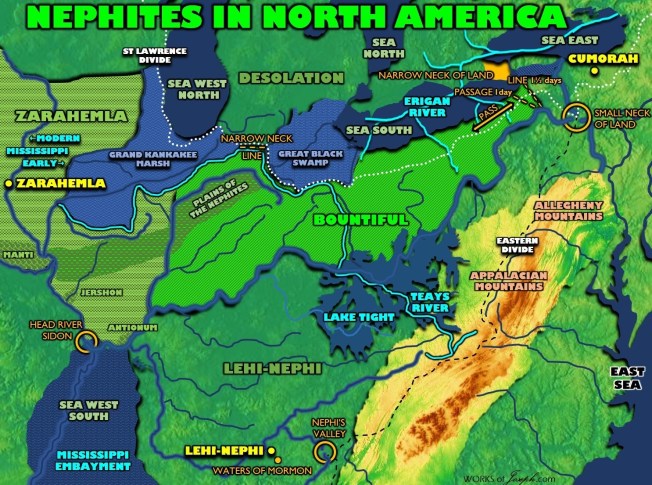

“For those who have thought of the Book of Mormon geography in terms of an hourglass shape (map left), here is a paradigm shift. Alma 22:27 says the border between the Nephites and Lamanites was a narrow strip of wilderness. Conceptually, think of it as a fence. (As I’ll show, it was a water barrier that acted as a border—effectively, a fence.)

Now, picture the small neck of land between the land of Nephi and the land of Zarahemla as a gate in the fence. Like many gates, the small neck of land required attention. It had to be defended. But it wasn’t the defining feature of the landscape, and it was not the narrow neck of the Jaredites… I propose that the narrow strip of wilderness is a major river—or system of rivers—that serves as an effective border. Continued Below

Introducing an additional inspirational speaker to our 32nd Book of Mormon Conference! To a trafficked child all that matters is rescue and healing. The SPEAR Fund collaborates with and funds anti-trafficking organizations to provide quick and effective action when it matters most. Ken Krogue![]()
You have heard Ken before, but never like this. Ken has been asked to be the President of Tim Ballard’s new venture called The SPEAR Fund to unify the efforts of anti-trafficking organizations and concerned patriots and citizens who want to end this scourge of trafficking. Conference Tickets Here
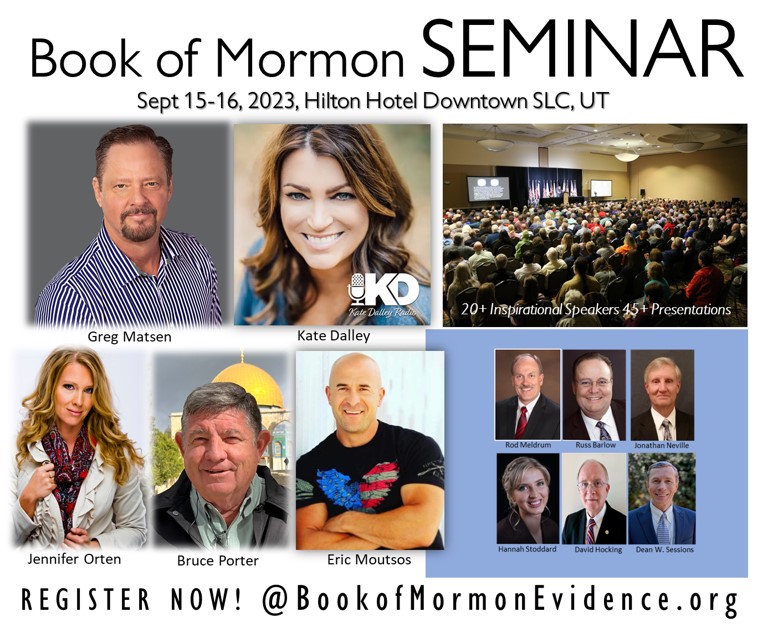
Continued: Here is my rationale. First, Moroni tells us it is a border. The “narrow strip” element suggests a feature that is visible and obvious to people on the ground; i.e., narrow enough that observers can see how wide it is, and long and thin enough that it is not mistakable. It is a definite border, not a vague region. Second, the definitions of the terms offer similar connotations. Narrow suggests a vale, valley, or river bed. Strip suggests something that is long and thin—like a river… In the past, however—in Book of Mormon times—the Ohio River often dried up in late summer. This left the riverbed as an expanse of silt and mud. In that state, it could not be called a river. But it could still be a border, and it could still be called a narrow strip of wilderness.” Moroni’s America page 23, 51-5
Alma 22 Geography
As you read below, follow the map as you read Alma 22:29-31 This will enable you to understand the principle areas of the Heartland of the Unites States in relation to the text description of the geography from the Book of Mormon. “And also there were many Lamanites on the east by the seashore, whither the Nephites had driven them. And thus the Nephites were nearly surrounded by the Lamanites; nevertheless the Nephites had taken possession of all the northern parts of the land bordering on the wilderness, at the head of the river Sidon, from the east to the west, round about on the wilderness side; on the north, even until they came to the land which they called Bountiful. 30 And it bordered upon the land which they called Desolation, it being so far northward that it came into the land which had been peopled and been destroyed, of whose bones we have spoken, which was discovered by the people of Zarahemla, it being the place of their first landing. 31 And they came from there up into the south wilderness. Thus the land on the northward was called Desolation, and the land on the southward was called Bountiful, it being the wilderness which is filled with all manner of wild animals of every kind, a part of which had come from the land northward for food.” Alma 22:29-31

Narrow Neck of Land
“It may be surprising to realize that the term “narrow neck of land” is used only once in the entire Book of Mormon. (Ether 10:20). Many think this term is the same as found in Alma 22:32 that says, “a small neck of land”. (Narrow doesn’t mean small). Besides, the narrow neck in Mesoamerica is over 140 miles wide. No location in Central America is surrounded by water because at both ends there are enormous continents. In North America, both the land of Zarahemla and the land of Nephi are nearly surrounded by water, with a small neck of land between them.” Moroni’s America page 21-22
The “Narrow Neck of Land” is a term from the Jaredite record. It makes sense to look for archaeology in Jaredite times.
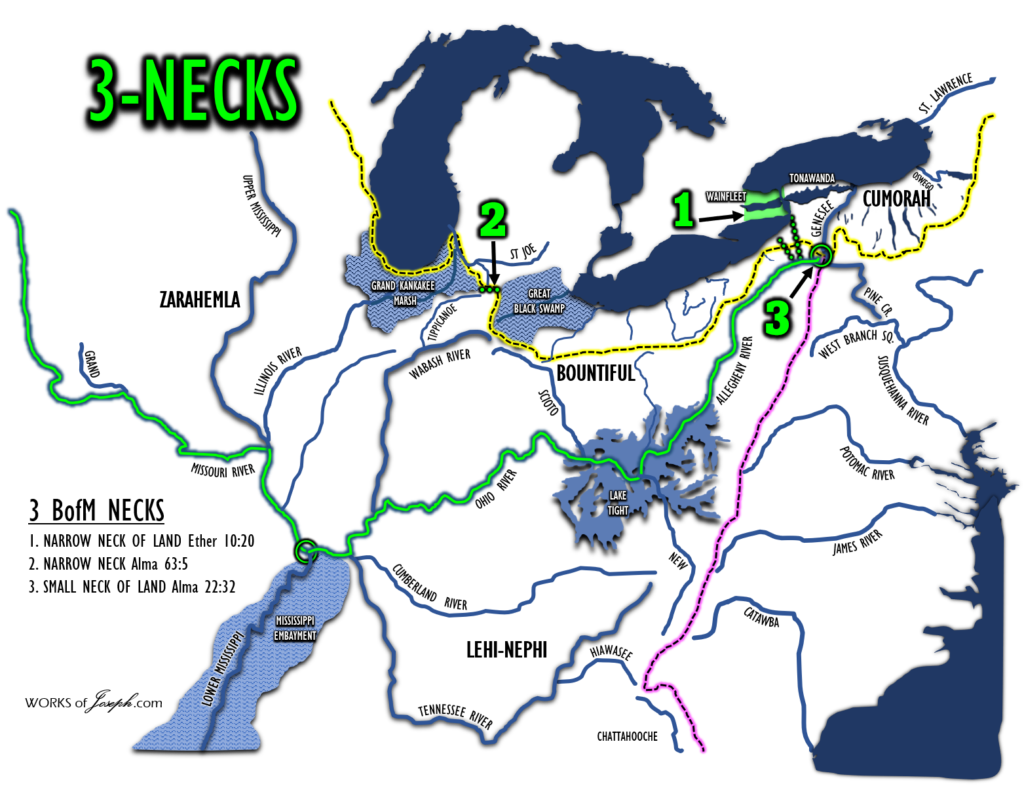
MAJOR LANDS OF ALMA 90-77 B.C. ALMA 22
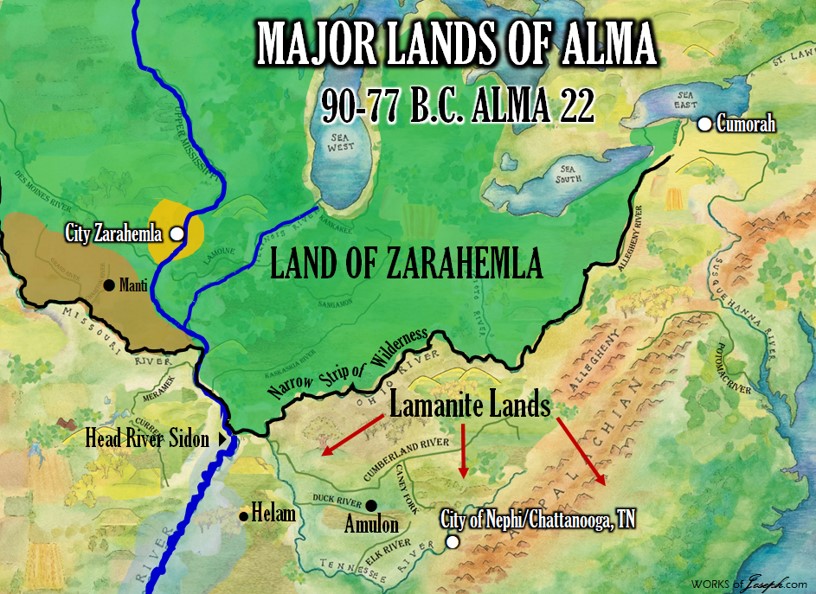
AMMON AND THE ANTI-NEPHI-LEHIS 90-77 B.C. Alma 27-28
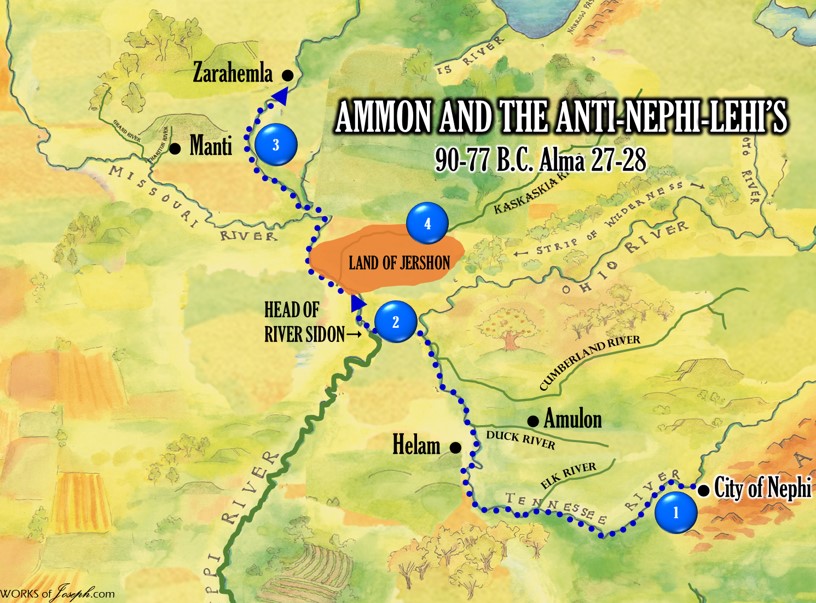
1.Ammon persuaded the Anti-Nephi-Lehis to follow him to the land of Zarahemla. (Probably using the Tennessee River which flows west to north. 2. When they reached the wilderness (Ohio River) that divided the land of Nephi from the land of Zarahemla, the people stayed near the borders. 3. Ammon went to the city of Zarahemla (Montrose, IA across the Mississippi from Nauvoo) to arrange for a land for his converts. On both sides of the Mississippi in that area, there are hills that provide natural defensive positions. 4. Ammon obtains the land Jershon for the refugees. A perfect refuse is on the north side of the Kaskaskia River and east of the Mississippi River to protect them on either side). Moroni’s America page 161
THE LAND OF JERSHON 90-77 B.C. ALMA 27:22-24
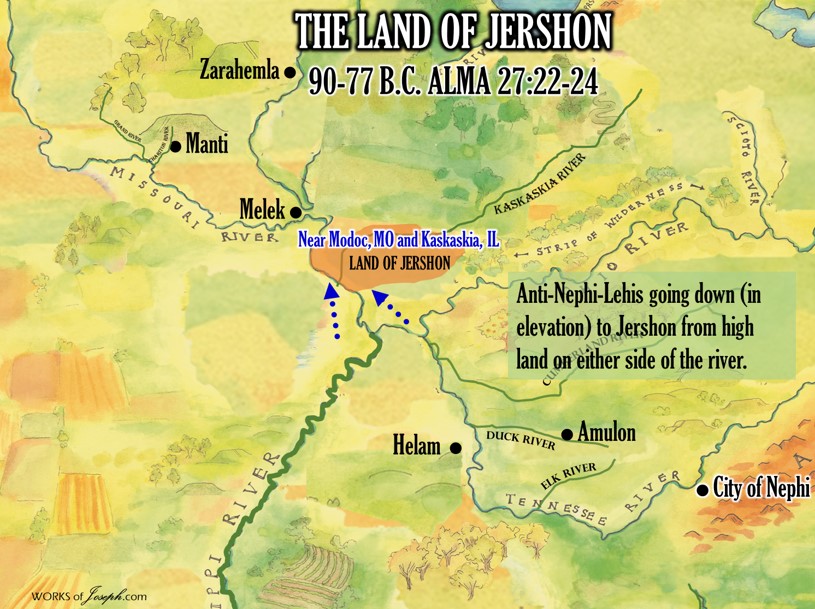
Rivers are the Highways of the Nephites

RAMEUMPTON & HILL ONIDAH ALMA 31-32
“For they had a place built up in the center of their synagogue, a place for standing, which was high above the head; and the top thereof would only admit one person…
18 And again we thank thee, O God, that we are a chosen and a holy people. Amen.
19 Now it came to pass that after Alma and his brethren and his sons had heard these prayers, they were astonished beyond all measure.
20 For behold, every man did go forth and offer up these same prayers.
21 Now the place was called by them Rameumptom, which, being interpreted, is the holy stand. Alma 31:13, 18-20
“And thus we see that when these Lamanites were led to believe and know the truth, they were steadfast and would suffer even death rather than commit sin; and so we see that they buried the weapons of peace, that is, they buried their weapons of war for peace.” Alma 24:19
“Now, as Alma was teaching and speaking unto the people upon the hill Onidah, there came a great multitude unto him, who were those of whom we have been speaking, of whom were poor in heart, because of their poverty as to the things of the world.” Alma 32:4
And now he had got the command of those parts of the Lamanites who were in favor of the king; and he sought to gain favor of those who were not obedient; therefore he went forward to the place which was called Onidah, for thither had all the Lamanites fled; for they discovered the army coming, and, supposing that they were coming to destroy them, therefore they fled to Onidah, to the place of arms. Alma 47:5-6
This name Onidah is very similar to Oneida which is a nation of the Iroquois Confederacy with another tribe the Onondaga of New York. The “place of arms” could very well be the place the Anti-Nephi-Lehis buried their weapons.
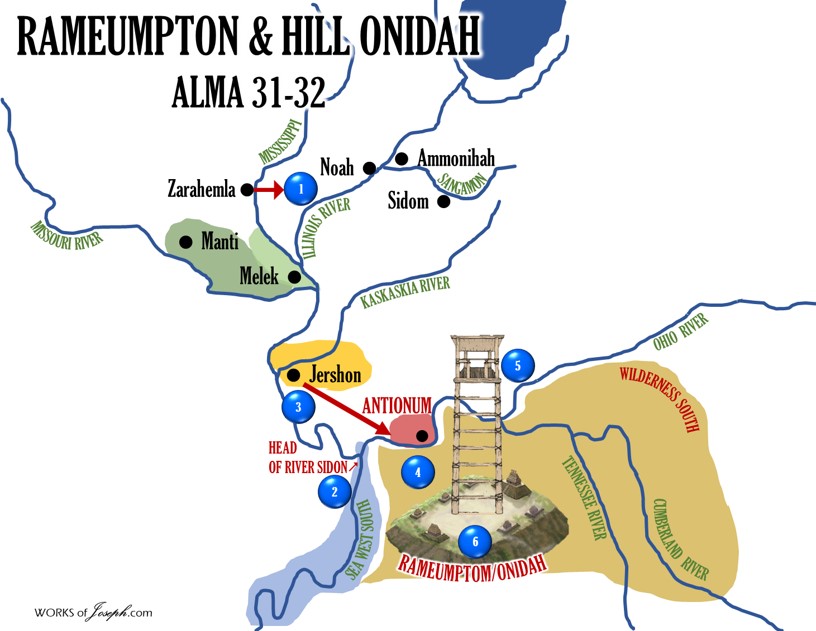
LAND OF ANTIONUM
“Now the Zoramites had gathered themselves together in a land which they called Antionum, which was east of the land of Zarahemla, which lay nearly bordering upon the seashore, which was south of the land of Jershon, which also bordered upon the wilderness south, which wilderness was full of the Lamanites.” Alma 31:3 (Near Paducah, KY)
Look at area on the map called Antionum. As you read the 6 steps below, Antionum must meet these 6 geographical locations.
1. East of the land of Zarahemla. (The Land Zarahemla includes Nebraska, Iowa, Illinois, and some of Indiana). 2. Nearly bordering upon the seashore. (Mississippi) 3. South of the land of Jershon. (Yes) 4. Bordered upon the wilderness south. (South of the Ohio River) 5. “Now the place was called by them Rameumpton, which, being interpreted, is the holy stand.” Alma 31:21 (Near Chattanooga TN which we believe is the City Lehi-Nephi). Blog Here 6. “Now, as Alma was teaching and speaking unto the people upon the hill Onidah, there came a great multitude unto him, who were those of whom we have been speaking, of whom were poor in heart, because of their poverty as to the things of the world.” Alma 32:4
ZORAMITE CONVERTS EXILED 74 B.C. ALMA 31:3-5
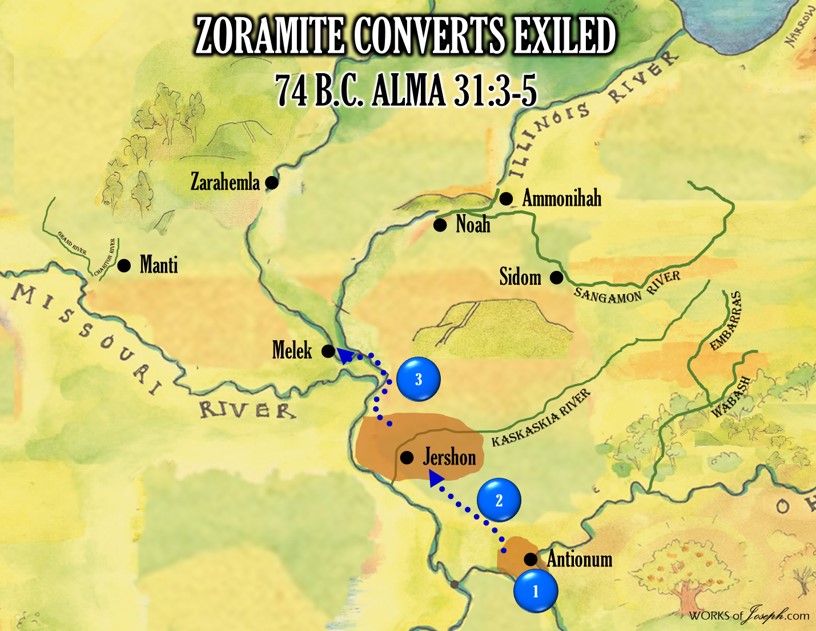
Hiawatha and Anti-Nephi-Lehites
The poem was published on November 10, 1855, by Ticknor and Fields and was an immediate success. In 1857, Longfellow calculated that it had sold 50,000 copies.[6]
Longfellow chose to set The Song of Hiawatha at the Pictured Rocks, one of the locations along the south shore of Lake Superior favored by narrators of the Manabozho stories. The Song presents a legend of Hiawatha and his lover Minnehaha in 22 chapters (and an Introduction). Hiawatha is not introduced until Chapter III.
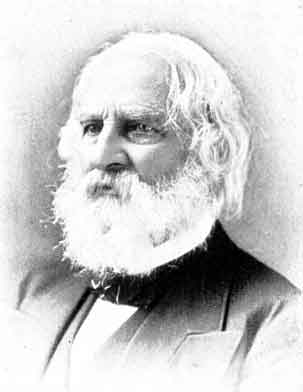
In Chapter I, Hiawatha’s arrival is prophesied by a “mighty” peace-bringing leader named Gitche Manito.
Chapter II tells a legend of how the warrior Mudjekeewis became Father of the Four Winds by slaying the Great Bear of the mountains, Mishe-Mokwa. His son Wabun, the East Wind, falls in love with a maiden whom he turns into the Morning Star, Wabun-Annung. Wabun’s brother, Kabibonokka, the North Wind, bringer of autumn and winter, attacks Shingebis, “the diver”. Shingebis repels him by burning firewood, and then in a wrestling match. A third brother, Shawondasee, the South Wind, falls in love with a dandelion, mistaking it for a golden-haired maiden.
In Chapter III, in “unremembered ages”, a woman named Nokomis falls from the Moon. Nokomis gives birth to Wenonah, who grows to be a beautiful young woman. Nokomis warns her not to be seduced by the West Wind (Mudjekeewis) but she does not heed her mother, becomes pregnant and bears Hiawatha.
In the ensuing chapters, Hiawatha has childhood adventures, falls in love with Minnehaha, slays the evil magician Pearl-Feather, invents written language, discovers corn and other episodes. Minnehaha dies in a severe winter.
The poem closes with the approach of a birch canoe to Hiawatha’s village, containing “the Priest of Prayer, the Pale-face.” Hiawatha welcomes him joyously; and the “Black-Robe chief” brings word of Jesus Christ. Hiawatha and the chiefs accept the Christian message. Hiawatha bids farewell to Nokomis, the warriors, and the young men, giving them this charge: “But my guests I leave behind me/ Listen to their words of wisdom,/ Listen to the truth they tell you.” Having endorsed the Christian missionaries, he launches his canoe for the last time westward toward the sunset and departs forever.
The story of Hiawatha was dramatized by Tale Spinners for Children (UAC 11054) with Jordan Malek. https://en.wikipedia.org/wiki/The_Song_of_Hiawatha
Book of Mormon as compared with Longfellow’s “Song of Hiawatha”
Thanks to my good friend Jayne Corbett for sharing this article with me.

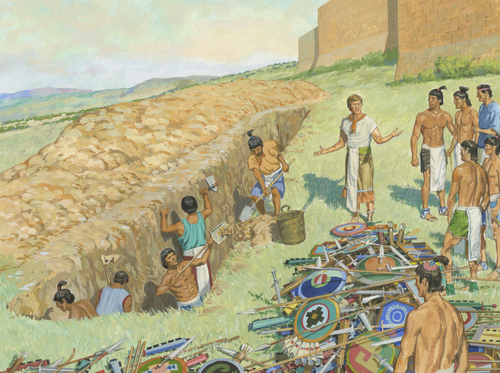
This particular article is a reprint from an early Foundation for Research on Ancient America newsletter no. 36 dated January 14, 1981 pg. 4 written by Gordon W. Harrison, of Sharon, Pennsylvania: There is an incident told in Alma 14, of the people of Anti-Nephi-Lehi taking their swords and all their weapons which were used for the shedding of man’s blood and burying them deep in the earth. They made a covenant with God that they would never again shed the blood of man. It is an unlikely story, isn’t it? So unlikely, in fact, that I would be willing almost to wager that there is only one other place in all this world that such a story as that can be found. That is in Longfellow’s “Song of Hiawatha.” I had a little of “Hiawatha” in high school. About all I could remember of it was their God Gitche Manito, Nokomis and the shores of Gitche Gumee, Hiawatha’s birch bark canoe and Minnehaha. I had never read all of the poem but I liked what I read so well that I could not forget it. Many years later, after I had become a member of the Reorgnized Church of Jesus Christ of Latter Day Saints, and had become familiar with the Book of Mormon, thoughts of Hiawatha came back to me and I inquired about it at the library. I took home a book of Longfellow’s poems with “The Song of Hiawatha” in it. I began reading, without the slightest idea of what I was going to find. I had not read very far before I discovered that I was receiving one of the greatest surprises of my life, for I was actually reading a short version of much of the Book of Mormon. With poetic license, Longfellow tells what the Indians believed in the way of legends and traditions as they were handed down through the ages, and of the things that had happened in the lives of their forefathers in the long ago. They believed in God who was their Creator and Master of Life. It was he who gave them everything. Hiawatha was their prophet and teacher and deliverer. He had a wondrous birth and being, much different from anyone else’s. In the first chapter God calls all the Indian tribes together and reprimands them for their fighting. He commands them to be at peace with one another and to live toghther as brothers, and counsels them in these words: “I will send a Prophet to you, a Deliverer of the nations, who shall guide you and shall teach you, who shall toil and suffer with you. If you listen to his counsels, you will multiply and prosper; if his warnings pass unheeded, you will fade away and perish!” He commanded them to bathe in the stream before them and wash themselves clean, which they did. This referred, no doubt, to their baptism, as it was remembered. God commanded them at the same time to bury their war-clubs and weapons (so like the people of Anti-Nephi-Lehis): “Then upon the ground the warriors threw their cloaks and shirts of deer-skin, threw their weapons and their war-gear, leaped into the rushing river, washed the war-paint from their faces. Clear above them flowed the water, clear and limpid from the footprints of the Master of Life descending; dark below them flowed the water, soiled and stained with streaks of crimson, as if blood were mingled with it!” If we could see the water after our baptism, as God sees it, maybe it would look that way, too. “From the river came the warriors, clean and washed from all their war-paint; on the banks their clubs they buried, buried all their warlike weapons. Gitche Manito, the mighty, the Great Spirit, the creator, smiled upon his helpless children!” Where else can you read a story like that except in the Book of Mormon? And about the same people! I suggest that you read “The Song of Hiawatha” studiously. You will find many things in it similar to the Book of Mormon. Longfellow said he got these legends and traditions from the Indians and he published his poem in 1855. Joseph Smith got his record from God and published it in 1830. Longfellow’s poem, Chapter 5, tells about Hiawatha’s prayer and fasting. Chapter 6 tells about the singer, singing of death, and life undying, in the land of the Hereafter. So the Indians knew about that. Chapter 13 says, “Buried was the bloody hatchet,” and “the dreadful war-club,” and all the “war-like weapons.” The warcry was forgotten and there was peace among the nations. They went about their hunting and their possessions were unmolested. Was this the “Golden Age” of the Nephites? There are to many similarities in these two stories, about the same people, to be just a coincidence. Don’t you think so, too? http://www.centerplace.org/library/bofm/hiawatha.htm





